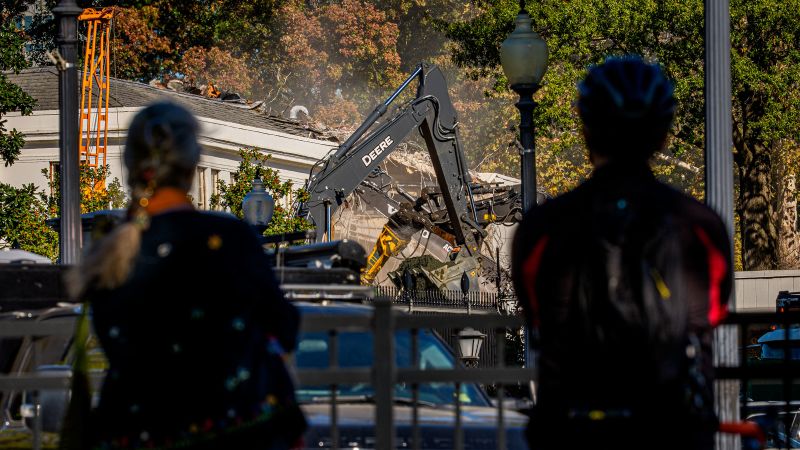Copyright Cable News Network

A version of this story appeared in CNN’s What Matters newsletter. To get it in your inbox, sign up for free here. The ballroom President Donald Trump is demolishing part of the East Wing of the White House to build is Caesars Palace meets the Palace of Versailles, which is the same taste Trump has brought to buildings for decades. It’ll cost $200 million, paid for by private interests who have business before the federal government. It’ll be 90,000 square feet, about two acres, which is bigger than a football field and smaller than a Costco. It would be easy to eye-roll at the addition of a massive party space to the White House, a residence that has been successfully hosting parties for hundreds of years. But this party room and event space are permanent additions to a home owned by Americans and is being built by a president who denied this week that he’s trying to be a king. The White House, not unlike the Weasley House, has been changing since construction first started in 1792, as Stewart McLaurin, president of the nonpartisan nonprofit White House Historical Association documented in a long post for LinkedIn. Thomas Jefferson added the colonnades that President Donald Trump has turned into a sort of hall of presidents. The British burned the place almost to the ground in 1814. Andrew Jackson added the north portico. Chester A. Arthur called in Louis Comfort Tiffany — yes, THAT Tiffany — to decorate. Teddy Roosevelt oversaw the construction of the West Wing, taking out greenhouses and gardens. William Howard Taft built the first Oval Office, which Trump has decorated with gold filigree. Franklin D. Roosevelt oversaw the construction of the East Wing, which Trump is now partially demolishing for the ballroom. Harry Truman got a full gut renovation. Jackie Kennedy put in the Rose Garden that Trump recently ripped out for a massive patio. Gerald Ford put in a swimming pool. Barack Obama engaged in the “big dig” that retrofitted the Situation Room and dug out space under the West Wing for who knows whatever else. In Trump’s first term, first lady Melania Trump put in a tennis pavilion and refurbished the Rose Garden he later covered in patio. Many of these efforts were criticized in their time, as McLaurin notes. When times are tough, as they invariably are for many Americans, presidents can be criticized for improving their living situation. Today the government is supposed to be closed, in large part, because Congress can’t pass a spending bill. But Trump’s privately funded ballroom construction carries on. It will be the first large-scale change to the White House facade in more than 80 years, something the Society of Architectural Historians said should be undertaken only after a deliberative process with special care taken to preserve the historic building. Trump recently hosted a dinner for donors at the White House that was attended by titans of industry and tech. Whatever fundraising process was undertaken by the Trump administration has not been publicly shared, although it thanked a list of attendees at the dinner. His view is that “I’m paying for it,” which does not technically appear to be the case. CBS reported that one source of funding is YouTube, which settled a lawsuit for suspending Trump’s account after the January 6 storming of the capitol for more than $24 million. That money is apparently going to the ballroom project. Trump recently hosted a dinner for donors at the White House that was attended by titans of industry and tech. No approval needed. And a focus on ‘classical’ architecture While Trump has criticized the Federal Reserve for changes to its plans that were okayed by the National Capital Planning Commission, the head of that group, which Trump stacked with supporters, said no approval at all is needed for the White House project. The architect on the project, James McCrery, is described by Catholic University, where he teaches, as having rethought his own modernist education in favor of classical architecture. He is known for designs for churches, including the Cathedral of the Most Sacred Heart of Jesus in Knoxville, Tennessee. Trump issued an executive order in August, “Making Federal Architecture Beautiful Again,” calling for government buildings to be built in the classical style. Where will the first ladies’ offices go? The historian Kate Andersen Brower, who has written books about the first ladies and the White House residence, noted for The Contrarian that FDR partially hid the construction of a World War II bomb shelter when he expanded the East Wing. In the years since, the East Wing has become mostly the purview of first ladies, a role Melania Trump has been less visible in performing than most of her predecessors. The advantage of replacing the current East Room, capacity 200, with an event space for 900 or so people will displace first ladies of the future, Brower wrote. “However Melania Trump feels about this loss, it will be a lasting blow to the hard-won stature of her role,” she argued. “First Lady is still an anachronistic and misunderstood job, one that comes with no official description, no pay, and endless expectations. Presidential spouses are scrutinized not just by the American people, but by the world at large. And now they may not even have a space to call their own.” The construction was jarring this week in part because it seemed to come out of nowhere. But planning has clearly been underway for months. The White House released plans for the ballroom over the summer. Trump may be moving on to another legacy project. A model for a victory arc in the style of the Arc de Triomphe or the Brandenburg Gate was recently displayed in the Oval Office.



